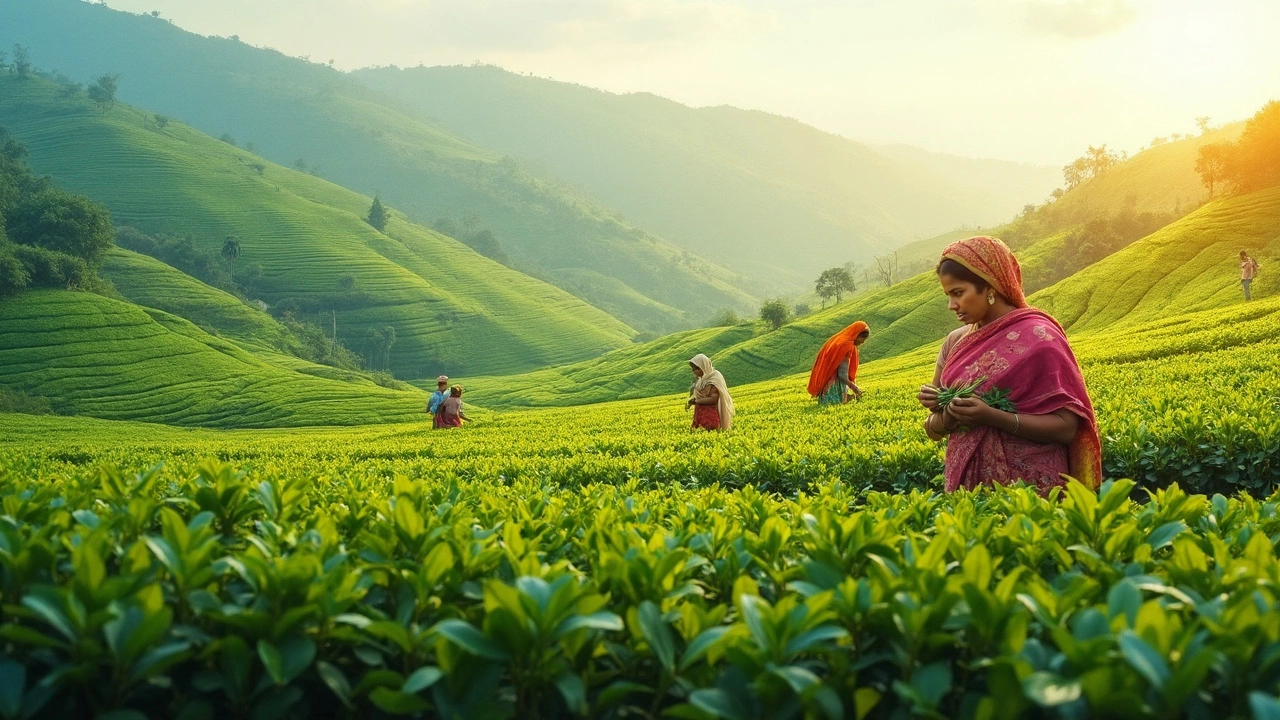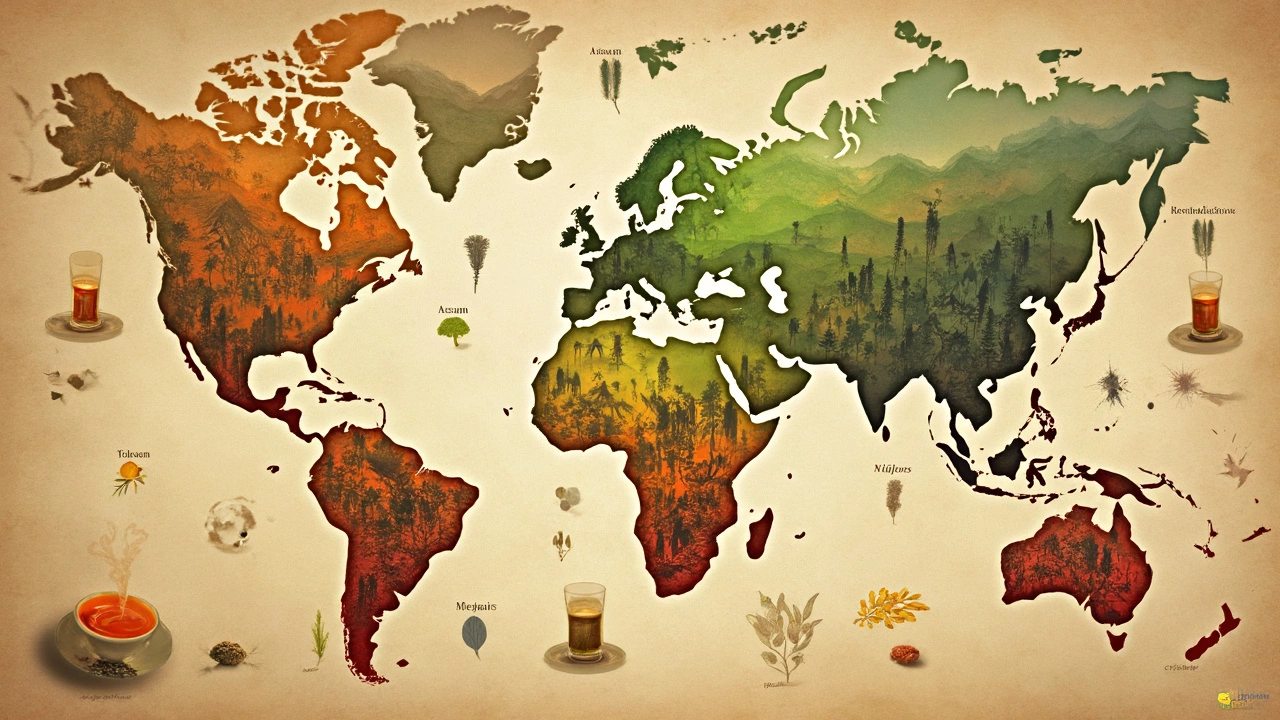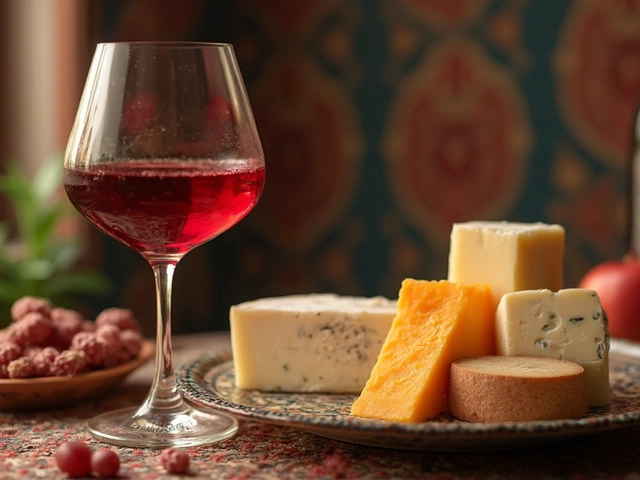
Ever wondered which country grows the most tea? It's not just about sipping that perfect cup; it's a whole world of stats and stories behind those leaves. First up, let me tell you about China. Yep, that’s the big one. With its sprawling tea farms, China churns out more tea than any other country on the planet. This isn’t just a recent thing—China’s got a tea history going back thousands of years.
Their secret? It’s partly about the sheer size of the place. But there's more to it. China's varied climate means they can grow all sorts of tea—everything from green to black, oolong to pu-erh. While we're here, a quick tip: if you get the chance, try tasting these different types back-to-back. You’ll be amazed at the range of flavors in just one country’s repertoire.
- Global Tea Production Overview
- The Reigning Tea Giant
- Other Key Players
- Why Climate Plays a Big Role
- Understanding Tea Varieties
- Tasting Tips for Different Teas
Global Tea Production Overview
When it comes to tea, the world can't seem to get enough. Globally, tea production keeps soaring, with recent numbers showing us just how massive this industry is. In general, three countries really dominate: China, India, and Kenya. Each brings something unique to the tea table.
First off, let’s talk China. With their long history in tea, it's no surprise that they lead the pack, producing nearly 40% of the world's tea. Their emphasis on quality and variety, including green tea and black tea, keeps them at the top.
Next up is India, the runner-up in the tea race. Known particularly for Assam and Darjeeling teas, India contributes about 20% to the global tea output. Their teas are loved for their robustness and distinct flavors. If you're exploring teas, Indian black teas are a must-try!
But don’t sleep on Kenya. They’re the star of Africa when it comes to tea. Mainly producing black tea, they have made a name for themselves with their efficient production methods, contributing around 9% to the world's tea supply.
South America and Southeast Asia are also starting to make waves in the tea scene, particularly with unique local varieties. While they don't match the giants yet, their contributions make the tea world more exciting and diverse.
| Country | Percentage of Global Tea Production |
|---|---|
| China | 40% |
| India | 20% |
| Kenya | 9% |
Each country’s climate and terrain play huge roles in the types of tea they produce. That's why when you're tasting a tea from any of these regions, you're not just enjoying a drink—you're experiencing a slice of that country's culture and environment.
The Reigning Tea Giant
So, who takes the crown in the world of tea? That would be China. It's the ultimate powerhouse when it comes to tea production. They’ve been in the game for over 3,000 years, so it’s no wonder they’ve got the whole process down pat. China doesn't just grow tea; they live and breathe it.
With tea gardens sprawling across provinces like Yunnan, Fujian, and Zhejiang, their production is massive. In fact, China's tea fields cover an area roughly equivalent to the size of Switzerland! This allows them not only to produce in large quantities but also to offer a variety of teas. They specialize in green tea, which makes up a huge chunk of what they grow, but they’re not limited to just that.
Curious about stats? Check this out: in 2023, China produced over 2.5 million metric tons of tea! This makes them the leading producer globally, far ahead of other countries. Wanna talk money? The tea industry pumps billions into China's economy every year, supporting millions of farmers and workers.
China's not just about the quantity—there’s plenty of quality and tradition packed into each cup. That’s why even though they produce a ton of tea, they also rank high in exports, sending their leaves to all corners of the globe. So next time you sip on a steaming cup of jasmine or oolong, there's a good chance it started its journey somewhere deep within China's verdant tea gardens.
Other Key Players
While China sits at the top of the tea world, it's definitely not alone in the global tea production game. India comes in hot on China's heels. Known for its iconic Assam and Darjeeling teas, India's climate and terrain make it a powerhouse for growing robust and flavorful tea varieties. Assam, in particular, is famed for producing some of the richest black teas around.
Now, let's take a trip to Kenya. Surprised? Many people don't realize that Kenya is a big player in the tea biz. Situated perfectly with its tropical climate, Kenya produces tons of tea—mostly black—and it's one of the leading exporters, especially to Britain and Pakistan. Their tea is known for its bright color and refreshing taste.
We've also got Sri Lanka in the spotlight, famous for its high-quality Ceylon teas. These teas boast a distinct flavor that many tea lovers rave about. Because of the country's varying altitude levels, they can produce tea with a range of flavors and colors.
Take a look at this quick breakdown of world tea export figures to get a better sense of how these countries stack up:
| Country | Tea Export (Metric Tons) in 2023 |
|---|---|
| China | 2,500,000 |
| India | 1,400,000 |
| Kenya | 500,000 |
| Sri Lanka | 290,000 |
These figures show just how significant these key players are in the world of tea. Next time you're sipping your morning brew, maybe switch it up and try a different country's offering. You might just find a new favorite!

Why Climate Plays a Big Role
If you're diving into the world of tea, you'll soon find that climate is a big player in what makes each cup unique. Different regions have climates that affect how tea plants grow, which in turn impacts the flavors that end up in your cup.
Take China, for example. With climates ranging from the tropical humidity of Yunnan to the cooler, misty mountains of Zhejiang, the variety is immense. This means they can produce a wide range of teas. In these diverse climates, the conditions like rainfall, temperature, and soil quality create a perfect environment for different types of tea.
It's not just about rain and sun, though. Tea plants are pretty picky about their surroundings. They love high altitudes, where cooler temperatures and less oxygen stress the plants just enough to enhance flavor. That’s why teas like Darjeeling—a type from India—are known for their exquisite taste, thanks to the unique Himalayan climate.
Now, here's something interesting: even within a single country, you’ll get massive differences. In India, you have Assam with its hot, humid environment producing bold black teas, while Darjeeling offers lighter, floral flavors because of its cooler, high-altitude climate.
So, when you're sipping your favorite brew, remember that the same leaves could taste wildly different if grown just a few hundred miles apart. Next time you buy tea, maybe look up where it's from. It might give you some insight into why that particular tea tastes the way it does!
Understanding Tea Varieties
So, you’re probably wondering why there are so many kinds of tea out there. The world of tea is as diverse as it is vast, with each type offering its own unique blend of flavors and aromas. Tea truly is more than just a hot drink; it’s an experience. Let’s break down the basics of the main types you’ll come across.
First up, green tea, which is hugely popular, especially in health-conscious circles. It's all about those antioxidants. This one’s made from unoxidized leaves and is one of the least processed types of tea. A lot of folks love its lighter flavor—give it a try if you haven't!
Next, there’s black tea. This is probably what comes to mind when you think of traditional tea. It's fully oxidized, making it strong and robust, and it's often the base for your classic breakfast tea.
"Understanding the nuances of tea is about more than just the taste—it's about exploring history and culture," said Emma Sutton, a noted tea sommelier with years of experience.
Then you have oolong, sitting between green and black tea in terms of oxidation. It’s known for its complex flavor, which can be floral or fruity, depending on how it’s processed.
Last, but not least, is pu-erh. Now, this is a bit different because it’s fermented. Many think of it as an acquired taste with its earthy, sometimes musty flavor. Interestingly, it's from the Yunnan Province in China, which is a bustling hub for tea production.
If you’re serious about exploring these varieties, make sure to check out tasting events. They’re a fantastic way to dive into the subtleties. Believe it or not, a lot of work goes into every cup you sip. Cheers to discovering your favorite!
Tasting Tips for Different Teas
Diving into the world of tea tasting can be as enjoyable as that first sip of the day. Whether you're new to it or a seasoned sipper, there are some straightforward tips to help you appreciate the full range of flavors different teas offer.
First and foremost, get familiar with the basic types of tea: green, black, oolong, and pu-erh. Each type has its own unique flavor profile, and knowing the difference is key to understanding what you're tasting. When you're ready to try them, start by brewing each properly—temperature and steeping time can make or break your experience:
- Green tea: Best brewed at around 70-80°C for 2-3 minutes. Look for a fresh, grassy aroma.
- Black tea: Needs boiling water at 100°C and about 3-5 minutes steeping time. Expect a rich, full-bodied taste.
- Oolong tea: Go for water around 85-90°C. Infuse it for 2-4 minutes to get those complex, floral notes.
- Pu-erh tea: Boiling water works best here, with a longer steep of 4-5 minutes. It should taste earthy and bold.
While tasting, use all your senses. Observe the color of the tea liquor and inhale its aroma before your first sip. When tasting, let the tea cover all parts of your tongue—this helps pick up the nuances in flavor. Spit or swallow the first sip, depending on your preference, but definitely savor it.
Between tastings, cleanse your palate with plain crackers or a sip of water. This resets your taste buds so that each type of tea can shine on its own. Everyone has their unique preferences, so don't worry if your favorite isn't what you expected.
Want to notch up your tasting? Keep a simple table to note down your thoughts on each tea. Something like this can help:
| Tea Type | Flavors | Notes |
|---|---|---|
| Green Tea | Fresh, Vegetal | Mild, Sweet |
| Black Tea | Rich, Malty | Smooth, Strong |
This will let you track what you like and explore new favorites. And remember, tea tasting isn't about finding 'the best' but discovering what suits your palate.





Categories